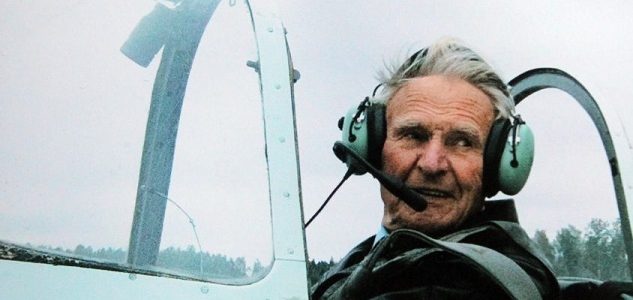Photo: Drupas in his Zlin 326A airplane, 2015.
With deep sadness we report the death of Righteous Gentile Vladas Drupas who rescued Jews as a young man. He was a rescuer and a pilot who flew up until his last breath. Let him go to his reward together with the other Righteous Gentiles who have passed on.
Drupas never considered himself a hero for rescuing Jews during the Holocaust. It was like pulling teeth to get him to even talk about the events of 1943 and 1944 in Šiauliai and environs where a silent battled against the Nazis took place in hiding individual Jews and Jewish families.
Virginija Skučaitė wrote about Drupas in the Kauno Diena newspaper in 2016. It was one of the last publications about the courageous man:
§§§
Winged Senior Saved Jewish Lives in Youth
by Virginija Skučaitė
October 3, 2016
Didn’t Know Any Jews
“At the beginning of the war I was in fifth grade at the Šiauliai Gymnasium. The Germans who established themselves in Šiauliai quickly banned the Jews already marked with yellow stars from walking the sidewalk. At that time I didn’t know any young Jews because our schools were segregated. In 1943 the Germans performed a medical check of young people in Šiauliai selecting them for military service. I had a check-up as well and my passport was taken, but I didn’t go to the collection point for youth at the time scheduled by the Germans. Of course I was nervous, not knowing how I would go to school in the fall without personal identification. But my classmate Bradauskas helped me, through his uncle who was a priest and who worked in some town, he got me a new passport. This fact later had gigantic significance as I began to rescue Jews from death,” said Drupas, who then lived in Šiauliai with his bachelor unclue Juozas Dapkus, whose tailor shop was famous throughout the city.
Got a New Passport
In the period between the two world wars many Jews visited this tailor shop. When the ghetto was established many Jews asked Dapkus for a certification showing they worked there. “My uncle issued more than a dozen such certificates, protecting Jews from hard forced labor and allowing them to leave the ghetto legally for ‘work.’ Among the tailor shop Jews there was the family of Leo and Mina Remen whose son was being hidden at the house of the family’s nanny. I became a messenger for members of the Remen family. And then I had the idea that I might be able to, through the classmate I mentioned, get new documents that looked like Mina Remen, like a Lithuanian girl–her hair was a blonde. Probably bleached with peroxide. I came up with a story for my classmate about a cousin of mine named Marija Ramanauskaitė whom the Germans wanted to take for labor to Germany and how she needed, as I had before, new identification papers because hers had been confiscated. My classmate believed it and I got a passport, and Mina became Marija Ramanauskaitė,” Drupas recalled, also adding he provided food to the Remen family living in the ghetto.
“In 1944 Leo Remen asked me to get his wife Mina out, for whom I got the new passport, to a safe place. I bought two tickets on a passenger train travelling to Radviliškis. I experienced great stress because a German officer in a pilot’s uniform entered our wagon and began talking Mina up. I explained to him my cousin didn’t speak German. The German was greatly disappointed by this, although Mina actually did speak German. In Radviliškis I took her to my mother and said this Jewish woman needed temporary shelter and that she should tell everyone Mina was my cousin. My mother agreed. A month later her husband Leo who had fled the ghetto somehow joined her, as did his brother, father and mother and two of Mina’s female cousins. They all left for Žemaitija to the home of some peasant whom I didn’t know,” Vladas Drupas recalled.


